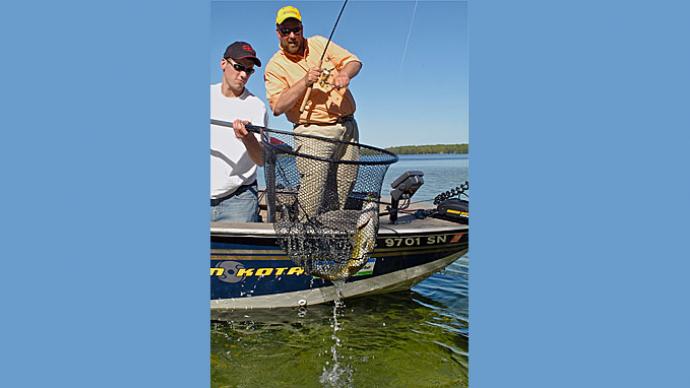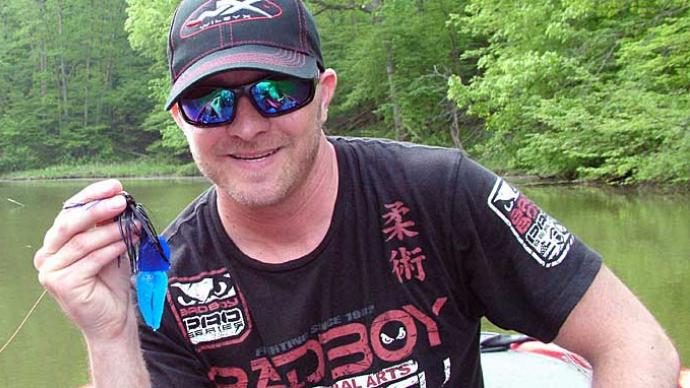Once you've coaxed that bass into striking your lure, it's time to get it into the boat. Here's how to do it.
Setting the Hook
Treble-hook lures often cause the bass to hook itself upon striking - often, but not always. The jaws of a bass are tough. It takes a solid impact and a sharp hook point to penetrate.
On crankbaits, when the strike occurs, snap back the rod tip quickly and reel until the line is tight. The strike's impact often sets the hooks, but by maintaining pressure on the fish, you can usually bury them deeper.,
With topwaters, waiting for a second before setting the hook is essential. An overreaction often results in your pulling the lure from the mouth of the bass.
Single-hook lures (jigs, plastic worms, spinnerbaits) require a strong, deliberate hookset on your part. Often the bass inhales the lure completely. Therefore you must drive the hook point home with a solid strike.
| DON'T | Tighten down on the fish and then sweep back with the rod tip. This will only turn the head of a big bass. |
| DO | Set the hook using the slack-line technique. Upon feeling the strike, turn to face the fish with the rod between 10 and 11 o'clock. Then drop the rod top quickly and snap the slack out of the line with a fast overhead strike. This will pound home the hook point like a hammer pounds a nail into a board. Always set the hook with a strong upward jerk. However, you don't need to tear the boat seat out of the boat on the hookset. If you're rigged right, the bass will practically hook itself. |
Setting the Drag
Your reel's drag allows line slippage. It's a precaution against a big fish or obstacle breaking your line.
| DON'T | Set the drag by adjusting the drag setting, then pulling line from directly in front to the spool. This can bury the line in the spool and gives an inaccurate reading of the line pull from the lure. |
| DO | Adjust the drag and then pull the line from past the rod tip, or tie a heavy object to the end of your line and adjust accordingly. A good rule of thumb is to set the drag not to exceed half that of the pound test of your line. A spring scale used in weighing fish can help set drag tension more accurately. |
Backreeling
Backreeling is a method of playing a fish on a spinning reel that bypasses the reel's drag system. Instead, the drag is tightened down, and the fisherman uses the reel handle to either take-in or pay out as the fish demands. With practice, the technique becomes easier, but beginners will find this method difficult to master. The advantage of backreeling is that line twists are often significantly reduced because you aren't reeling while the bass pulls the line against the drag. On light line, you must try to second-guess the bass when backreeling-anticipate its next move - never an easy tack.
Landing a Fish
Bass have no teeth, as do many other game fish; therefore they can be easily landed without the use of a net, with practice. Landing nets may damage the fish you wish to release.
Lip-Landing Method
- When the fish is ready to come in, use the rod to draw it close to the boat. Do not reel up a lot of line. The rod's spring action will act as a shock absorber should the fish decide to make one last run at the boat.
- Draw the rod back over one shoulder and extend your arm. Maintain pressure on your line. Slowly pull the bass toward your grasp.
- Carefully press your thumb against the tip of the jaws if the mouth is shut. This will cause it to open. Then firmly clench the lower jaw between thumb and forefinger.
- On a big bass, wait one second. Then put down your rod and use your other hand to grasp the jaw.
- Lift the bass aboard.
Net Method
Many bass are lost at the landing net. Net your fish carefully but remember that landing nets will damage the bass's scales, fins, and slime coating
- Bring the bass alongside the boat.
- Put the net into the water, making sure the netting is not tangled.
- Draw the fish toward the net; the fish will usually swim into it.
- Scoop the fish up using a single, smooth motion. Don't try to net the bass downward, and do not swipe at a bass that is not ready to come aboard.
Preventing Problems
- Remember, the harder you fight, the harder the fish fights. Once you pull him from the cover, let up and let the bass tire out before bringing him to the boat.
- If a bass swims under the boat, extend your arms as far as they will go with rod in hand, thereby giving you extra leverage. Maintain pressure; you can usually draw the fish out into the open again. Avoid hitting the trolling motor start button while the bass is under the boat. You can cut your line.
- Don't fight or pull the fish in the opposite direction it's heading. Instead, turn him by guiding his head.
- Don't panic. Use the tools at hand: your rod, reel, line, and brain. Horsing a big fish to the boat usually means losing it.
- Don't try to pull a bass out buried in weeds or other heavy cover. You'll usually tear out or straighten the hook. Instead, it's wiser to move toward the bass with the boat.
- Long rods are an asset when playing a big fish. They provide more shock-absorbing power, move more line when setting the hook and give you more control over the bass.
- Even a professional fisherman loses some fish. Learn from your mistakes, but don't let them ruin your fishing trip.
- Whatever you do when landing the bass, DO NOT grab the line, especially on a big fish. I lost a 6-pound largemouth and a 4-pound largemouth last year because I had no patience to wait until the time was right to lip the bass. It is a hard habit to break but worth the effort. -- Joe
- When fishing early in the morning, use a Yellow Sally on the weed beds and work it fast. I have found this produces a lot of strikes and usually bigger fish. -- Colbie




